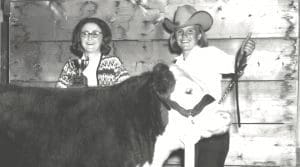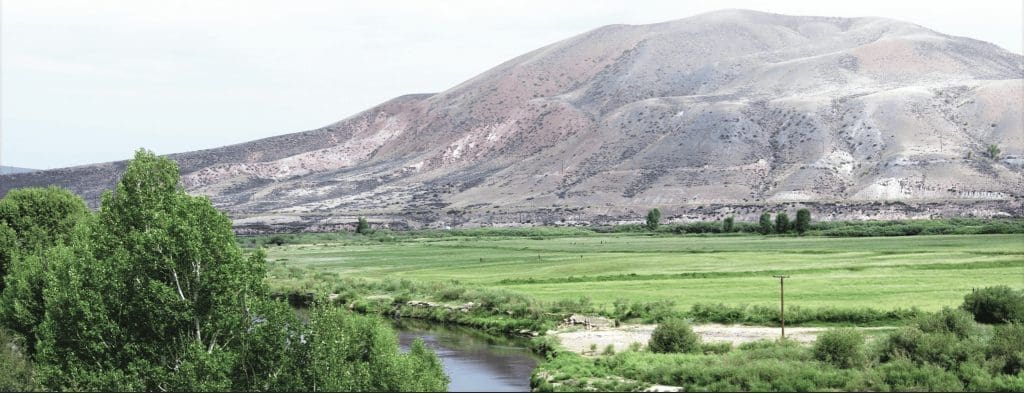By Micky Burch, Contributing Editor

It was a five-mile descent off The Mountain with nine kids – five Orr children and four from various hired hands and neighbors – crammed in a one-seater pickup to get to school every morning. “It was pretty crowded, and I’d usually have a stack of books,” Gena Orr Burch recalls. “I can still hear our lunch boxes clamoring around. Sometimes it was a little iffy getting off The Mountain.”
The Mountain, near Kremmling, Colo., was originally home to Virginia Smith’s family – Gena’s mother. Gena’s father, Ted, grandfather, Ted Sr., and Uncle Jack purchased the ranch from the Smith family and established Orr Cattle Company. “It was my mom’s side of the family’s ranch, and then dad’s family bought it when I was 5,” she further explains. “My mom grew up on that place.”
If they rode the bus home, Virginia would pick all the kids up at the base of The Mountain for the hike back home. Being next to the oldest of six kids, Gena helped with her younger siblings, but also spent time choring and riding her bike after school. Other times, she says, “I stayed in town with Grandma Smith – once a week or if it stormed and we couldn’t get home.”
Gena grew up with a slew of cousins, attending school with 14 of them. “It was great because we cousins chummed around together,” Gena remembers. As they got older and more independent, the cousins were allowed to stay in town after school at times. “We’d go Jerry’s Café, eat French fries and drink pop,” she says.
In her early teen years, Gena had a Hereford steer that was reserve champion the Grand County Fair in Kremmling. She sold him through the fair sale, but she’d fallen in love with him and convinced her dad to buy him back after the sale. They had a friend in Denver who was going to the Chicago International Livestock Show and arranged a ride for the steer, while Gena and Ted made plans to fly to the show. It was Gena’s first time on an airplane. “I had butterflies for a month before we went,” she says.
Virginia donned Gena in a new dress patterned in blue pinstripes. After Ted and Gena got off the plane and gathered their luggage, the handle on Gena’s suitcase broke, so Ted had to pack it around as they navigated the big city. Noticeably, there were bars on all the storefront windows and doors. “That was bothersome,” Gena remembers. “It was so different because the farmers were wearing hoodies and bibs,” she says. “I thought, ‘Well, this isn’t ranch country.’”
By the time they made it to the grounds, her steer was dripping in sweat and had shrunk 50 to 75 pounds, but they got him hydrated and ready to show. “I was in the ring for a good hour, and I stood first for about a half hour, then the judge put me third,” Gena says, still a little disappointed.
“After the show in Chicago, I got to cryin’ because I didn’t want to let that steer go,” she continues. Ted arranged for another family to buy him and they took him on to the National Western Stock Show in Denver. “He was third again,” Gena laughs. “He was never fat enough, but he was a good steer.”
At one point, the Orrs teamed up with the Mathias family out of Greeley, Colo., and Gena particularly idolized daughter Loretta. “She was five years older than me and she was amazing with cattle,” Gena remembers of the Shorthorn breeder. “I just thought they were the cat’s meow.” On one occasion, Loretta took Gena home with her to Greeley, a trip that made Gena feel extra special.
In 1966, Orr Cattle Company took 67 head of cattle – bulls and feeder cattle – to Denver and had the champion feeder calf pen. Gena was failing high school geometry that year. “I was horrified. Mrs. Swan wasn’t going to let me go to Denver,” she recalls. “I begged my dad to let me go. I told him I would make up some test or something so that I could go to Denver. Sure enough – I got to go.”
In addition to Denver, the Arizona National Livestock Show in Phoenix was an annual family affair with Grandpa Ted, Gena says.
Grandpa Ted also taught Gena how to rake hay with her sitting on his lap while he sat on an iron seat of a John Deere B tractor; she was about 12 years old. “Holy cow were we raking hay,” she exclaims of riding with her grandpa. “I thought we were going to fall off!”
But no matter what, Grandpa Ted took care of Gena. “Him and Hal Ruby,” a seasonal hired cowboy, she explains. Gena was relentless about being included with the cowboys. “I was always scared they were going to leave me,” she says. Most likely that wasn’t going to happen, though. As she got older, the hired men would have Gena drive the truck on the way down to the calving grounds so they could roll their cigarettes.
They’d start at 8 a.m. when checking or moving cattle on the “Smith” by getting their gear gathered. Then, “We’d start off the hill, sliding through the wet fields and then we’d ride out about 10 miles before our day even got started.”
At night they rode back on the Noonan Ditch, oftentimes in storms or mud, starting back about 4 or 5 p.m. and getting in about 6 or 7 p.m.
Just prior to the start of calving, March 20, the crew would push 350-plus head of bred Herefords off the “Smith” down to Grandpa Ted’s where they calved on the Colorado River just outside Kremmling, “and I was not going to get left behind,” Gena states, a little stubbornly. “It was cold and we had on our snow pants and all our gear. Those horses would get ice clods underneath their hooves and they’d be slipping on the highway. We’d usually have a couple cows calve along the way and a tourist bus come through from Denver. I thought everything was just great,” Gena remembers. “So exciting!”
They’d start working pairs back up The Mountain in the latter part of June, sorting them out one at a time. Those were long days, starting at 4 or 4:30 a.m. Rainstorms were common, with lightning storms in the afternoon. “I always thought Jesus was coming, but I loved it,” Gena says. “You had to make sure you got your lunch and your slicker, and your cinch tight, and you always got on your horse on the uphill side and you didn’t screw around.”
Horses were vital to the ranch work. The ranch horses were broke as 4-year-olds and were started in the round corral. “Before we rode, we wrangled, caught four or six head, fed them oats and brushed them before saddling,” Gena remembers. “Those horses would never kick. They never messed with you. Those were the best horses.
“I started riding when I was 9 years old. Those were good horses – they knew how to lunge, how to get out of a slew, how to pull themselves up a muddy hill,” Gena says. “They’d work up a big sweat during the day in those mountains working.”
Gena remembers a horse named Maude who was half work horse. “She was kind of lazy, but she would take care of kid,” she says. “Even if I was sick, I was going to ride – I would drive Mom and Dad crazy.” Eventually, Gena roped cattle to help the cowboys treat lump jaws, foot rot and various other ailments.
Gena’s dad put her on Big Enough, a bay horse, when she was 12 years old. When Ted passed away in September of 2017, Gena says, “I got through the funeral by picturing myself post trotting on that horse. Coming home we’d post trot for about 10 miles like we were in the military. That horse was about the only horse you could ride two days in a row. He was so beautiful and powerful.
“I liked the showing – I enjoyed all that. And the horses,” she recollects. “And I still love it today. Agriculture is extremely important.”








